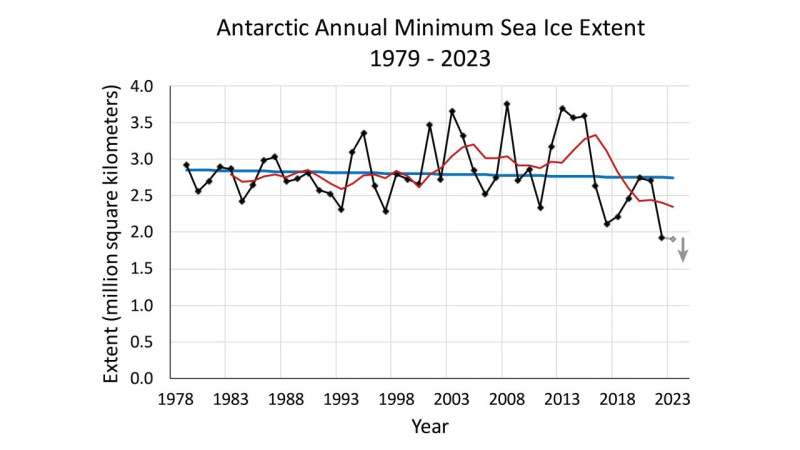Sea ice surrounding Antarctica fell to just 737,000 square miles, a significant drop from the previous low of 741,000 square miles on February 25 last year
At a new record low Antarctic sea ice has retreated for the second time in two years, with some scientists worried that this new retreat is a signal that the climate crisis may now be more clearly affecting this vast, complex and isolated region.
Sea ice surrounding Antarctica fell to just 737,000 square miles (1.91 million square kilometers) on February 13, according to the National Snow and Ice Data Center (NSIDC), a significant drop from the previous low of 741,000 square miles. miles (1.92 million square kilometers) on February 25 last year.
The sea ice it could however shrink further. The past two years mark the only time sea ice extent has fallen below 2 million square miles since satellites began tracking it in 1978.
“It’s not just ‘almost a record low,'” Ted Scambos, a glaciologist at the University of Colorado Boulder, told CNN. “It is in a very steep downward trend” he underlined.
Unlike the Arctic, where the rate of sea ice loss has followed a fairly steady downward trajectory as climate change accelerates, Antarctic sea ice extent fluctuates, making it harder to understand how the continent and surrounding ocean are responding to global warming.
Climate models predicted declines in Antarctic sea ice which was similar to the Arctic, but until recently the region behaved quite differently than these models predicted.
“The question is, has climate change reached Antarctica? Is this the beginning of the end? Will the sea ice disappear for good in the coming years in the summer?’ asks Christopher Haas, Head of the Sea Ice Physics Research Department at the Alfred Wegener Institute in Germany speaking to CNN.
Several factors can influence why sea ice is so low, including winds, ocean currents, and ocean heat. Air temperatures were warmer than usual in parts of Antarctica, about 1.5 degrees Celsius above the long-term average.
Another important parameter is the belt of westerly winds that circle Antarctica, known as the Southern Annular Mode. Those winds — which can accelerate the melting of sea ice — were stronger than usual, according to the NSIDC.
The strength of the winds has been linked, in part, to the increase in pollution from planetary warming as well as the hole in the ozone layer over the continent.
There are also estimates that sea ice may be melting because of heat trapped just below the ocean’s surface, Ted Scambos said.
“Basically, you get heat that gets stirred up in the upper layer [του νερού] around Antarctica,” he said. If this theory holds true and is linked to general ocean warming, “then this has major implications for the stability of the Antarctic ice sheet.”
Disappearing sea ice could have cascading effects in Antarctica and beyond. A changed landscape in the area could have significant impacts on wildlife, from the microorganisms and algae that support the food chain to the penguins and seals that rely on the sea ice for feeding and resting.
Carlos Moffat, an oceanographer at the University of Delaware who just returned from a research trip to the Antarctic Peninsula, told CNN that the low ice and very warm ocean temperatures they found “are dramatically different than what we’ve seen in recent years , a few decades ago”.
Source: Skai
I have worked as a journalist for over 10 years, and my work has been featured on many different news websites. I am also an author, and my work has been published in several books. I specialize in opinion writing, and I often write about current events and controversial topics. I am a very well-rounded writer, and I have a lot of experience in different areas of journalism. I am a very hard worker, and I am always willing to put in the extra effort to get the job done.











